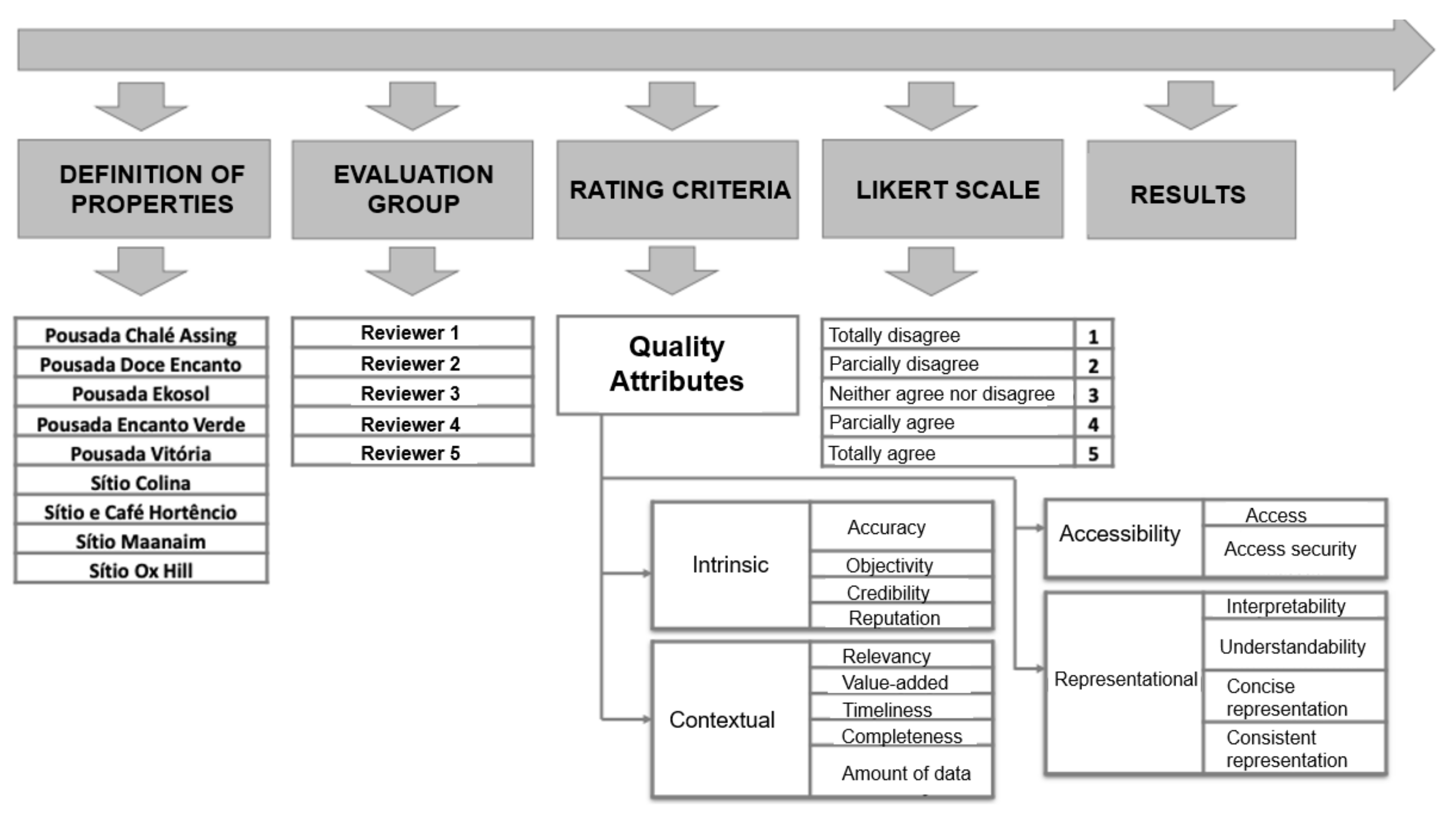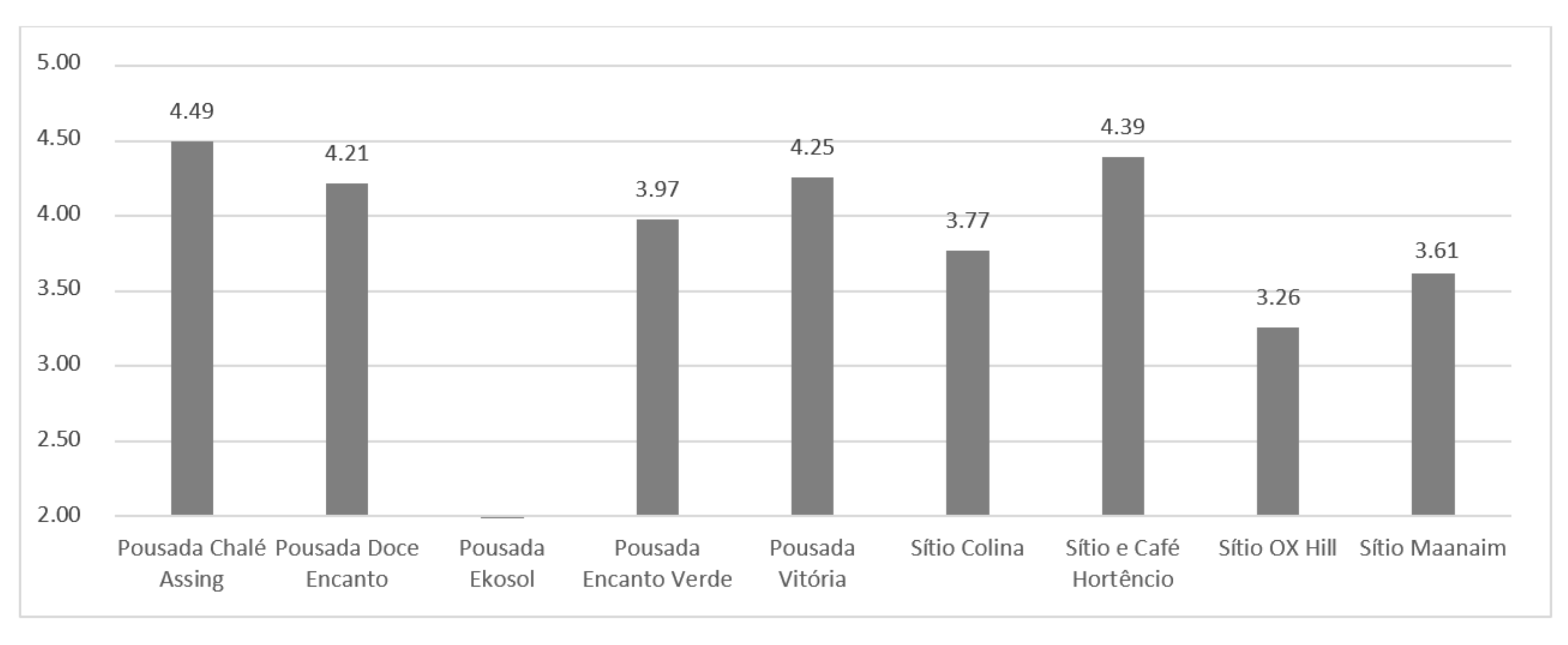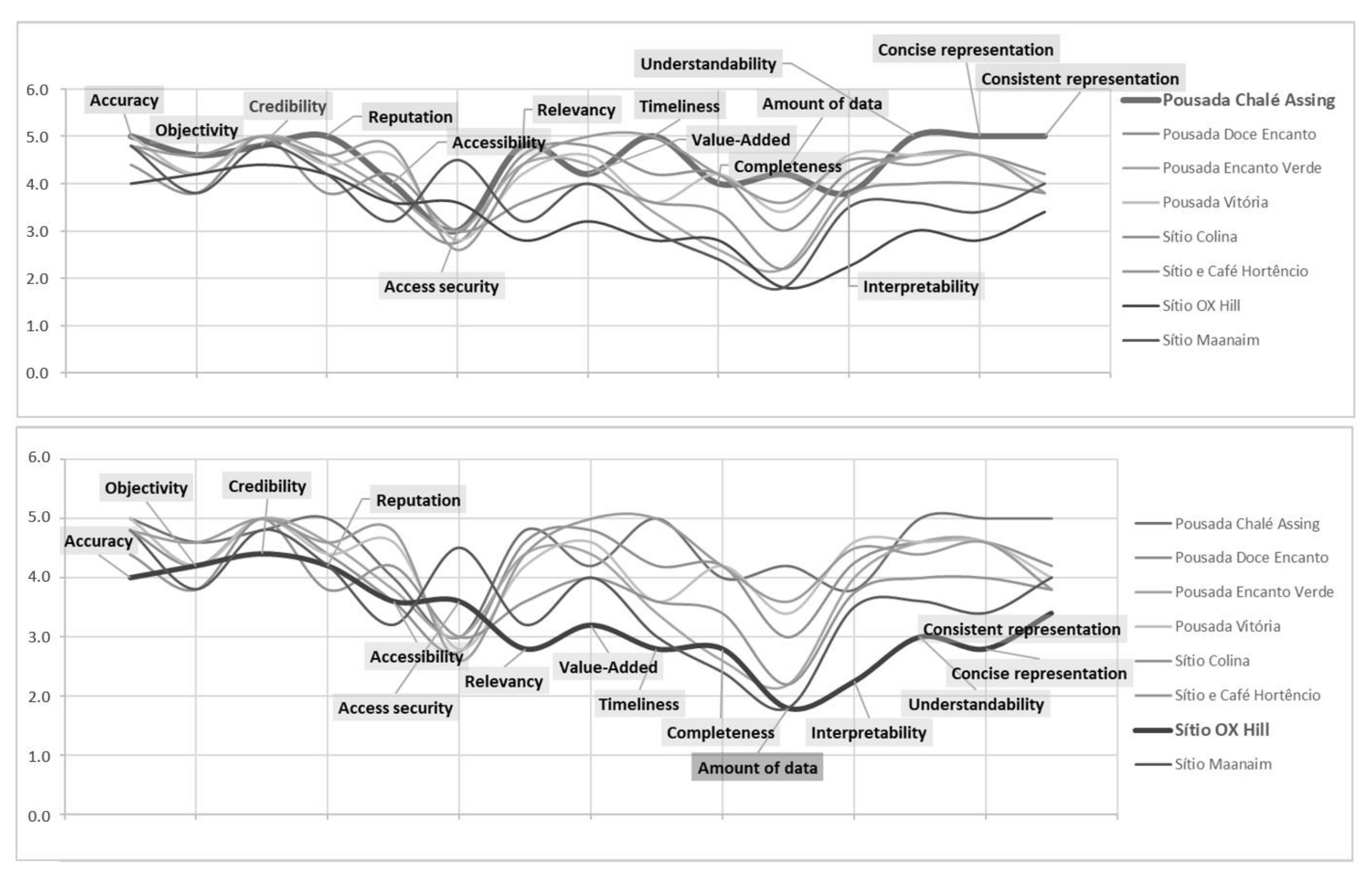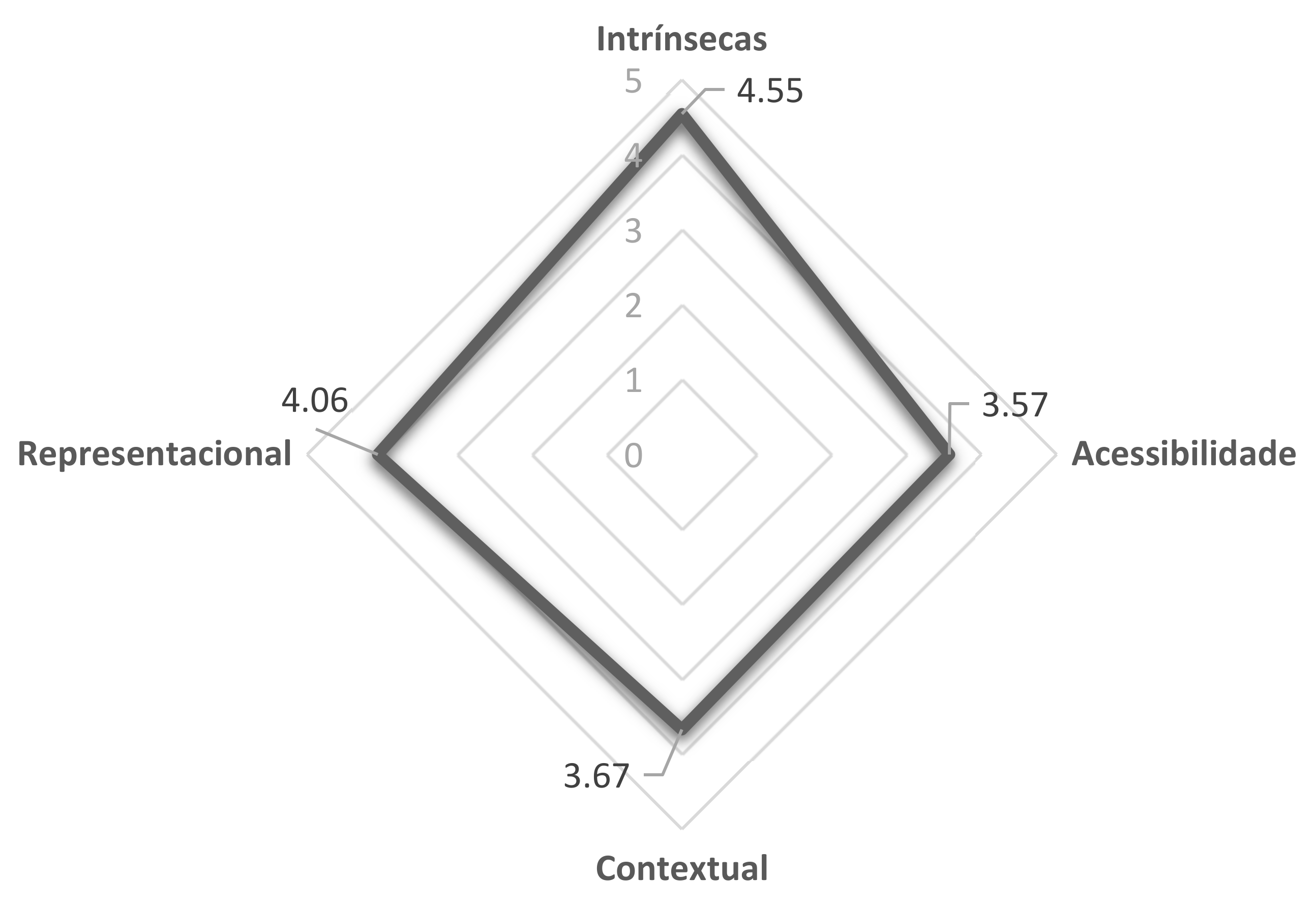Quality of Information and Marketing of Rural Tourism Experience
Abstract
:1. Introduction
2. Literature Review
2.1. Communication and Marketing in Tourism Destinations
2.2. Quality Information
3. Research Methodology
3.1. Experience Tourism Destinations—Acolhida na Colônia—SC
3.2. The Use of Social Media as a Marketing Strategy in the Study Site: Application and Experience
3.3. Methodology Steps
4. Discussion and Results
Quality Information on the Acolhida na Colônia Association’s Social Media
5. Conclusions
Author Contributions
Funding
Institutional Review Board Statement
Informed Consent Statement
Data Availability Statement
Conflicts of Interest
References
- UNWTO. Panorama OMT Del Turismo Internacional, Edición 2013; World Tourism Organization (UNWTO): Madrid, Spain, 2013; ISBN 9789284415519. [Google Scholar] [CrossRef]
- Miranda, A.A.B. O Conceito de Território e as Recentes Políticas de Desenvolvimento Rural e Suas Contradições No Estado Do Maranhão. Rev. Políticas Públicas 2012, 16, 123–132. [Google Scholar]
- Machado, Á.; Tomazzoni, E. A Regionalização Turística Do Rio Grande Do Sul e Sua Contribuição Como Referência Para a Gestão Regionalizada Do Turismo No Brasil. Rev. Bras. Pesqui. Tur. 2011, 5, 226–247. [Google Scholar] [CrossRef]
- Santos, M. A Natureza Do Espaço: Técnica, Razão e Emoção; Editora da Universidade de São Paulo: São Paulo, Brazil, 2004. [Google Scholar]
- Fernández-Arroyo López-Manzanares, A.; Martínez Sánchez-Mateos, H.S. El Acceso a Los Destinos Rurales: Una Perspectiva Para La Planificación Territorial Del Turismo En Una Región de Interior (Castilla-La Mancha). Cuad. Tur. 2017, 40, 251–272. [Google Scholar] [CrossRef] [Green Version]
- Sampaio, C.A.C.; Zamignan, G. Estudo Da Demanda Turística: Experiência de Turismo Comunitário Da Microbacia Do Rio Sagrado, Morretes (PR). Cult. Cult. Tur. 2012, 6, 25–39. [Google Scholar]
- Netto, A.P.; Oliveira, J.L.S.; Severini, V.F. Do Overtourism à Estagnação. Reflexões Sobre a Pandemia Do Coronavírus e o Turismo. Cenário Rev. Interdiscip. Tur. Territ. 2020, 8, 26–43. [Google Scholar] [CrossRef]
- Huang, K.T.; Lee, Y.W.; Wang, R.Y. Quality Information and Knowledge; Prentice-Hall: New York, NY, USA, 1999. [Google Scholar]
- Flores, L.C.S.; Mendes, J.C. Perspectivas Do Destino Turístico: Repensando o Sentido Do Conceito. Rev. Bras. Pesqui. Tur. 2014, 8, 222–237. [Google Scholar] [CrossRef] [Green Version]
- Batra, A. Destination Competitiveness: Amazing Bangkok versus Lion City Singapore. Enl. Tour. Pathmak. J. 2017, 7, 154–178. [Google Scholar] [CrossRef]
- Buhalis, D. Marketing the Competitive Destination of the Future. Tour. Manag. 2000, 21, 97–116. [Google Scholar] [CrossRef] [Green Version]
- Dwyer, L.; Kim, C. Destination Competitiveness: Determinants and Indicators. Curr. Issues Tour. 2003, 6, 369–414. [Google Scholar] [CrossRef]
- Moral, M.M.; Alles, M.T.F. Nuevas Tendencias Del Marketing: El Marketing Experiencial. Rev. Enteléquia 2012, 14, 237–251. [Google Scholar]
- Buhalis, D.; Law, R. Progress in Information Technology and Tourism Manage Ment: 20 Years on and 10 Years after the Internet—The State of ETourism Research. Tour. Manag. 2008, 29, 609–623. [Google Scholar] [CrossRef] [Green Version]
- Oliveira-Brochado, A.; Gameiro, C. Toward a Better Understanding of Backpackers’ Motivations. Tékhne 2013, 11, 92–99. [Google Scholar] [CrossRef]
- Kotler, P.; Bowen, J.T.; Makens, J.C.; Miranda, J.G.D.M.; Zamora, J.F. Marketing Turístico, 5th ed.; Pearson: Madrid, Spain, 2011; ISBN 9788483228081. [Google Scholar]
- Smith, K.; Hanover, D. Experiential Marketing: Secrets, Strategies, and Success Stories from the World’s Greatest Brands; John Wiley & Sons: New York, NY, USA, 2016. [Google Scholar]
- Perinotto, A.R.C.; Soares, J.R.R. Photographic Image, Credibility, and Consumption of Tourism in the Digital Era. In Digital Marketing Strategies for Tourism, Hospitality, and Airline Industries; Advances in Marketing, Customer Relationship Management, and E-Services; Santos, J.D., Silva, Ó.L., Eds.; IGI Global: Hershey, PA, USA, 2020; ISBN 9781522597834. [Google Scholar]
- Sin, K.Y.; Mohamad, A.A.; Lo, M.-C. A Critical Review of Literature in the Rising Tide of Social Media towards Promoting Tourism. Enl. Tour. Pathmak. J. 2020, 10, 270. [Google Scholar] [CrossRef]
- Gretzel, U.; Fuchs, M.; Baggio, R.; Hoepken, W.; Law, R.; Neidhardt, J.; Pesonen, J.; Zanker, M.; Xiang, Z. E-Tourism beyond COVID-19: A Call for Transformative Research. Inf. Technol. Tour. 2020, 22, 187–203. [Google Scholar] [CrossRef]
- Bertolazzi, P.; Scannapieco, M. Introducing Data Quality in a Cooperative Context. In Proceedings of the Sixth International Conference on Information Quality, Cambridge, MA, USA, 2001; pp. 431–444. [Google Scholar]
- Trindade, A.L.B.; Oliveira, M. Atributos Para Avaliação Da Qualidade Da Informação Em Sistemas de Gestão Do Conhecimento. In Proceedings of the I Encontro de Administração da Informação, Florianópolis, Spain, 2007; pp. 1–14. [Google Scholar]
- Strong, D.M.; Lee, Y.W.; Wang, R.Y. Data Quality in Context. Commun. ACM 1997, 40, 103–109. [Google Scholar] [CrossRef]
- Lee, Y.W.; Strong, D.M.; Kahn, B.K.; Wang, R.Y. AIMQ: A Methodology for Information Quality Assessment. Inf. Manag. 2002, 40, 133–146. [Google Scholar] [CrossRef]
- Guzzatti, T.C. O Agroturismo Como Elemento Dinamizador Na Construção de Territórios Rurais: O Caso Da Associação de Agroturismo Acolhida Na Colônia Em Santa Rosa de Lima (SC). Ph.D. Thesis, Universidade Federal de Santa Catarina, Florianópolis, Spain, 2010. [Google Scholar]
- Iglesias-Sánchez, P.P.; Correia, M.B.; Jambrino-Maldonado, C.; de las Heras-Pedrosa, C. Instagram as a Co-Creation Space for Tourist Destination Image-Building: Algarve and Costa Del Sol Case Studies. Sustainability 2020, 12, 2793. [Google Scholar] [CrossRef] [Green Version]
- Perinotto, A.R.C.; Alves, C.E.S.; Silva, L.F.; Vieira, V.B. O Espaço Turístico de Parnaíba-PI Nas Fotografias Online: Um Estudo Na Rede Social Instagram. Obs. Inov. Tur. 2020, 14, 1–22. [Google Scholar]
- Altermann, D. Mídias Sociais, Storytelling e Crossmedia—Entrevista Com Bruno Scartozzoni. Available online: https://www.midiatismo.com.br/midias-sociais-storytelling-e-crossmedia-entrevista-com-bruno-scartozzoni (accessed on 8 November 2020).
- Gonçalves, J.C.P. Histórias de Cultura. O Poder Do Storytelling Em Destinos de Turismo Cultural. Cad. Geogr. 2018, 37, 113–120. [Google Scholar] [CrossRef]
- Calazans, A.T.S. Qualidade Da Informação: Conceitos e Aplicações. Transformação 2008, 20, 29–45. [Google Scholar] [CrossRef] [Green Version]
- Olaisen, J. Information Quality Factors and the Cognitive Authority of Eletronic Information. In Information Quality: Definitions and Dimensions, Proceedings of a NORDINFO Seminar, Copenhagen, Denmark, 10–12 December 1989; Taylor Graham: London, UK, 1990; pp. 91–121. [Google Scholar]
- Baptista, S.G.; Cunha, M.B. Estudo de Usuários: Visão Global Dos Métodos de Coleta de Dados. Perspect. Ciênc. Inf. 2007, 12, 168–184. [Google Scholar] [CrossRef]
- Malhotra, N. Pesquisa de Marketing: Uma Orientação Aplicada, 6th ed.; Bookman: Porto Alegre, Brazil, 2012. [Google Scholar]
- Soares, J.R.R.; Gabriel, L.P.M.C. Credibilidad En Redes Sociales: Uso de Fuentes Orgánicas En Los Medios. In Las Fuentes de Información Turística en Foco; Aranzadi Thomson Reuters: Cizur Menor, Spain, 2018; pp. 59–70. [Google Scholar]
- O’Connor, P. Distribuição Da Informação Eletrônica Em Turismo e Hotelaria; Bookman: Porto Alegre, Brazil, 2001. [Google Scholar]
- Alvares, D.F.; Dos Santos, S.R.; Perinotto, A.R.C. Network of Tourism Observatories toward Tourism Intelligence: The Case of Brazil. Enl. Tour. Pathmak. J. 2020, 10, 140–178. [Google Scholar] [CrossRef]




| Categories | Dimensions |
|---|---|
| Intrinsic | Accuracy: data is correct and reliable |
| Objectivity: data is unbiased and impartial | |
| Believability: data is regarded as true and credible | |
| Reputation: data is highly regarded in terms of its source or content | |
| Accessibility | Accessibility: data is available, or easily retrievable |
| Access security: data is restricted appropriately to maintain its security | |
| Contextual | Relevancy: data is applicable and helpful for the task at hand |
| Value-Added: data is beneficial and provides advantages from its use | |
| Timeliness: data is sufficiently up-to-date for the task at hand | |
| Completeness: data is not missing and is of sufficient breadth and depth for the task at hand | |
| Amount of data: volume of data is appropriate | |
| Representational | Interpretability: data is in appropriate languages and the definitions are clear |
| Understandability: data is easily comprehended | |
| Concise representation: data is compactly represented | |
| Consistent representation: data is presented in the same format |
| Category | Dimensions | Pousada Chalé Assing | Pousada Doce Encanto | Pousada Ekosol | Pousada Encanto Verde | Pousada Vitória | Sítio Colina | Sítio e Café Hortêncio | Sítio OX Hill | Sítio Maanaim | Overall Average |
|---|---|---|---|---|---|---|---|---|---|---|---|
| Intrinsic | Accuracy | 5.0 | 4.8 | - | 5.0 | 5.0 | 4.4 | 4.8 | 4.0 | 4.8 | 4.73 |
| Objectivity | 4.6 | 4.2 | - | 4.2 | 4.2 | 3.8 | 4.6 | 4.2 | 3.8 | 4.20 | |
| Believability | 4.8 | 5.0 | - | 5.0 | 5.0 | 5.0 | 5.0 | 4.4 | 4.8 | 4.88 | |
| Reputation | 5.0 | 4.4 | - | 4.6 | 4.4 | 3.8 | 4.6 | 4.2 | 4.2 | 4.40 | |
| Intrinsic Average | 4.85 | 4.60 | - | 4.70 | 4.65 | 4.25 | 4.75 | 4.20 | 4.40 | 4.55 | |
| Accessibility | Accessibility | 4.0 | 3.6 | - | 3.8 | 4.6 | 4.2 | 4.8 | 3.6 | 3.2 | 3.98 |
| Access security | 3.0 | 2.8 | - | 3.0 | 2.8 | 3.0 | 2.6 | 3.6 | 4.5 | 3.16 | |
| Accessibility Average | 3.50 | 3.18 | - | 3.40 | 3.70 | 3.60 | 3.70 | 3.60 | 3.85 | 3.57 | |
| Contextual | Relevancy | 4.8 | 4.6 | - | 4.4 | 4.2 | 3.6 | 4.4 | 2.8 | 3.2 | 4.00 |
| Value-Added | 4.2 | 4.8 | - | 4.4 | 4.6 | 4.0 | 5.0 | 3.2 | 4.0 | 4.28 | |
| Timeliness | 5.0 | 4.2 | - | 3.4 | 3.6 | 3.6 | 5.0 | 2.8 | 3.0 | 3.83 | |
| Completeness | 4.0 | 4.2 | - | 2.6 | 4.2 | 3.4 | 4.2 | 2.8 | 2.4 | 3.48 | |
| Amount of data | 4.2 | 3.0 | - | 2.2 | 3.4 | 2.2 | 3.6 | 1.8 | 1.8 | 2.78 | |
| Contextual Average | 4.44 | 4.16 | - | 3.40 | 4.00 | 3.36 | 4.44 | 2.68 | 2.88 | 3.67 | |
| Representational | Interpretability | 3.8 | 4.3 | - | 4.0 | 4.6 | 3.8 | 4.5 | 2.3 | 3.5 | 3.83 |
| Understandability | 5.0 | 4.6 | - | 4.6 | 4.6 | 4.0 | 4.4 | 3.0 | 3.6 | 4.23 | |
| Concise | 5.0 | 4.6 | - | 4.6 | 4.6 | 4.0 | 4.6 | 2.8 | 3.4 | 4.20 | |
| Consistent | 5.0 | 4.2 | - | 3.8 | 4.0 | 3.8 | 3.8 | 3.4 | 4.0 | 4.00 | |
| Representational Average | 4.70 | 4.41 | - | 4.25 | 4.45 | 3.89 | 4.33 | 2.86 | 3.63 | 4.06 | |
| Overall Average | 4.49 | 4.21 | - | 3.97 | 4.25 | 3.77 | 4.39 | 3.26 | 3.61 | ||
Publisher’s Note: MDPI stays neutral with regard to jurisdictional claims in published maps and institutional affiliations. |
© 2022 by the authors. Licensee MDPI, Basel, Switzerland. This article is an open access article distributed under the terms and conditions of the Creative Commons Attribution (CC BY) license (https://creativecommons.org/licenses/by/4.0/).
Share and Cite
Walkowski, M.d.C.; Perinotto, A.R.C.; Vieira, V.B.; Santos, A.I.G.P. Quality of Information and Marketing of Rural Tourism Experience. Knowledge 2022, 2, 429-442. https://doi.org/10.3390/knowledge2030025
Walkowski MdC, Perinotto ARC, Vieira VB, Santos AIGP. Quality of Information and Marketing of Rural Tourism Experience. Knowledge. 2022; 2(3):429-442. https://doi.org/10.3390/knowledge2030025
Chicago/Turabian StyleWalkowski, Marinês da Conceição, André Riani Costa Perinotto, Vinicius Boneli Vieira, and Anna Isabelle Gomes Pereira Santos. 2022. "Quality of Information and Marketing of Rural Tourism Experience" Knowledge 2, no. 3: 429-442. https://doi.org/10.3390/knowledge2030025







